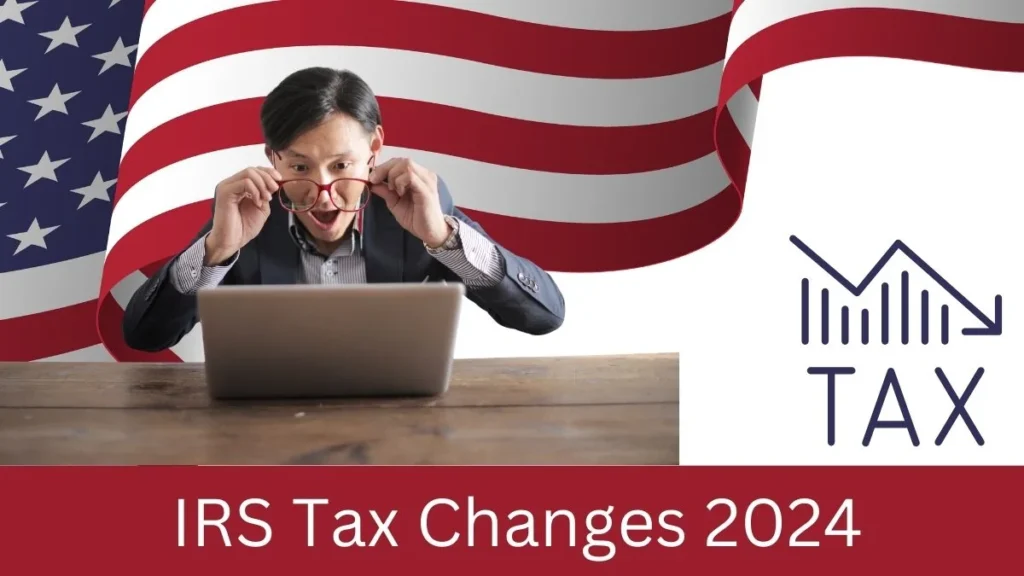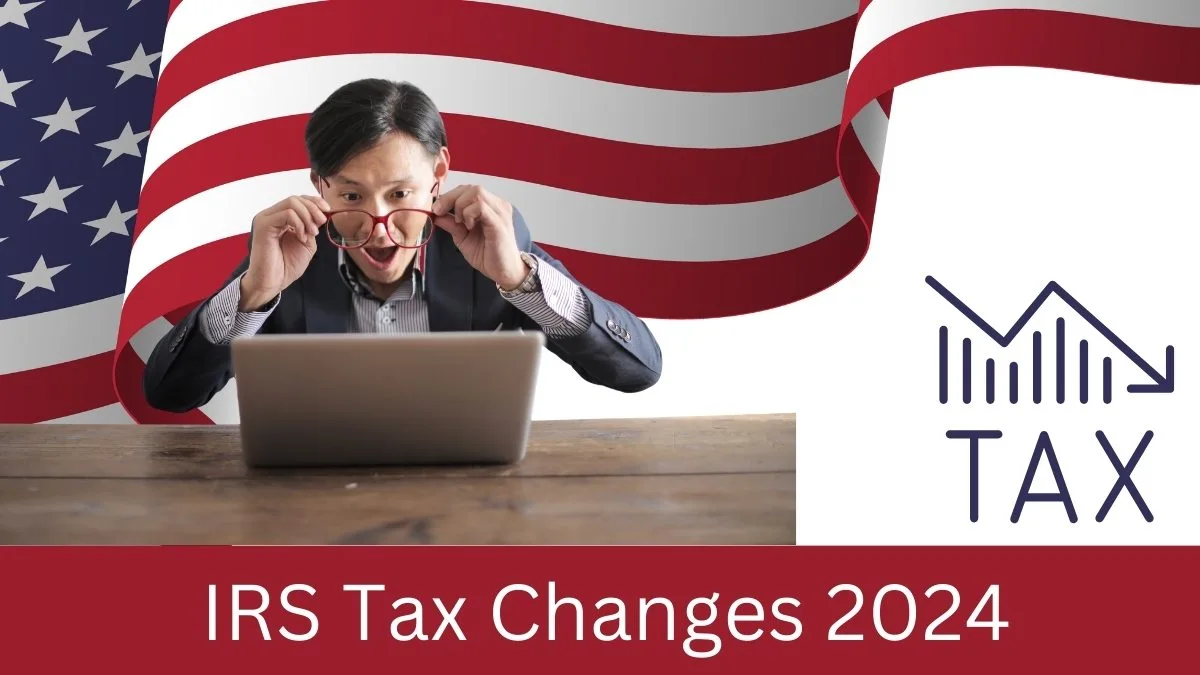Discover the latest on IRS Tax Changes in 2024: Unveiling the Tax Rate Adjustments in the USA. The Internal Revenue Service has introduced significant modifications for the year 2024. These adjustments not only raise the income tax brackets but may also influence the amount on taxpayers’ paychecks. Stay informed with the complete details on these tax updates.

IRS Tax Changes 2024:
The Internal Revenue Service (IRS) has unveiled key adjustments to the 2024 tax code, acknowledging the persistent inflationary pressures impacting many taxpayers. While income tax rates remain unchanged, both federal and standard deduction brackets will see a 5.4% increase, effectively mitigating the impact of rising living costs on individual tax burdens.
This upward revision in tax brackets signifies a proactive approach from the IRS to ensure taxpayers aren’t inadvertently subjected to higher tax rates solely due to inflation. The adjusted thresholds offer potential tax relief for individuals across income levels, particularly those nearing existing bracket boundaries.
However, it’s crucial to recognize that these changes don’t translate to a decrease in the overall tax burden. The primary aim is to maintain relative tax fairness in the face of inflationary pressures. Careful financial planning and familiarization with the updated tax brackets remain essential for navigating the 2024 filing season effectively.
The IRS provides comprehensive resources and tools to help taxpayers understand the implications of these adjustments. Additionally, consulting a qualified tax professional can be beneficial for individuals with complex financial situations or those seeking personalized guidance.
By proactively adapting to the evolving economic landscape, the IRS aims to ensure a more equitable tax system for all. By staying informed and actively managing finances, taxpayers can navigate the 2024 season with confidence and potentially realize valuable tax savings.
IRS Tax Changes 2024:
While individual income tax rates remain unchanged for the 2024 tax year, the Internal Revenue Service (IRS) has implemented adjustments to address inflationary pressures impacting taxpayers. These adjustments primarily focus on expanded tax brackets and increased standard deductions:
1. Adjusted Tax Brackets: Both federal and standard deduction brackets have increased by 5.4%. This essentially mitigates the effect of inflation on individual tax burdens, ensuring taxpayers don’t fall into higher brackets solely due to rising costs of living.
2. Enhanced Standard Deduction: The standard deduction, a universally available deduction offered to all taxpayers, has also been adjusted upwards by 5.4%. This directly reduces taxable income for individuals across all income levels, offering tangible tax relief.
3. Unchanged Tax Rates: It’s important to note that the actual income tax rates for each bracket remain the same as in 2023. The lowest rate remains 10%, and the highest remains 37%. This provides continuity and predictability for taxpayers familiar with the existing tax structure.
These adjustments offer potential tax benefits for individuals across the income spectrum, particularly those nearing existing bracket boundaries. However, it’s crucial to remember that these changes don’t represent a decrease in overall tax liabilities. The primary aim is to maintain relative tax fairness in the face of inflationary pressures
Individual Income Tax Brackets
Single Individuals
| Taxable Income (USD) | Marginal Tax Rate |
|---|---|
| $0 – $11,600 | 10% |
| $11,601 – $47,150 | 12% |
| $47,151 – $100,525 | 22% |
| $100,526 – $191,950 | 24% |
| $191,951 – $243,725 | 32% |
| $243,726 – $609,350 | 35% |
| $609,351 or more | 37% |
Married Couples Filing Jointly
| Taxable Income (USD) | Marginal Tax Rate |
|---|---|
| $0 – $23,200 | 10% |
| $23,201 – $94,300 | 12% |
| $94,301 – $201,050 | 22% |
| $201,051 – $383,900 | 24% |
| $383,901 – $487,450 | 32% |
| $487,451 – $731,200 | 35% |
| $731,201 or more | 37% |
More:
- The Internal Revenue Service (IRS) has adjusted tax brackets upwards by 5.4% to account for inflation, ensuring relative tax fairness for individuals across income levels.
- While brackets have expanded, actual tax rates within each bracket remain unchanged from 2023, providing continuity for taxpayers.
- The standard deduction has also been increased for 2024, offering additional tax relief to eligible individuals and households.
- These brackets apply to income earned in the 2024 tax year, to be filed in 2025.
- Taxpayers are encouraged to consult the IRS website or seek guidance from qualified tax professionals for comprehensive information and tailored advice.
Additional Insights
- The IRS has implemented a pilot program for direct filing in select states, potentially streamlining the filing process for eligible taxpayers.
- Reporting thresholds for third-party payment platforms have been lowered to capture a wider range of transactions, emphasizing tax compliance.
IRS Tax Updates 2024:
The Internal Revenue Service (IRS) has unveiled its tax code adjustments for 2024, reflecting the current economic climate marked by rising inflation and cost-of-living pressures. While headlines may suggest a blanket 5.4% increase in tax rates, a closer analysis reveals a more nuanced picture aimed at maintaining tax fairness and offering targeted benefits to taxpayers across income levels.
Key Policy Modifications:
- Inflation-Responsive Tax Brackets: Both federal and standard deduction brackets will expand by 5.4%, effectively shielding taxpayers from inflation-induced bracket creep and potential tax increases. This signifies a proactive approach to ensure continued tax fairness in the face of economic fluctuations.
- Enhanced Earned Income Tax Credit: The maximum allowable credit for qualifying taxpayers rises to $7,830, representing a vital boost to financial security for low- and moderate-income families. This policy shift underscores the IRS’s commitment to alleviating the burden of inflation on vulnerable populations.
- Expanded Transit Benefit: The qualified transportation fringe benefit limit increases by $15, enabling employers to offer employees enhanced tax-advantaged commuter assistance. This initiative encourages sustainable transportation choices while providing tangible benefits to taxpayers.
- Realigned Health FSA Contributions: The IRS implements modulated adjustments to salary contribution limits for health flexible spending arrangements. The individual limit slightly decreases to $3,250, while the family limit expands to $4,250, recognizing diverse healthcare needs within families.
Beyond Rates:
It’s crucial to note that individual income tax rates within each bracket remain unchanged from 2023. Additionally, the standard deduction receives a 5.4% boost, further reducing taxable income for individuals and families. These changes apply to income earned in 2024, filed in 2025.
VISIT USAOFFBEAT HOMEPAGE FOR LATEST INFORMATION
